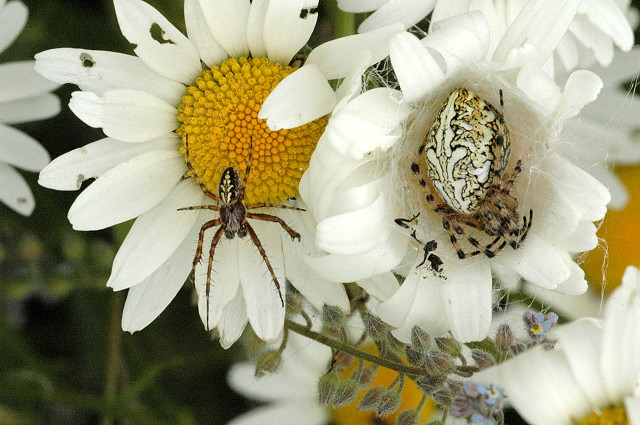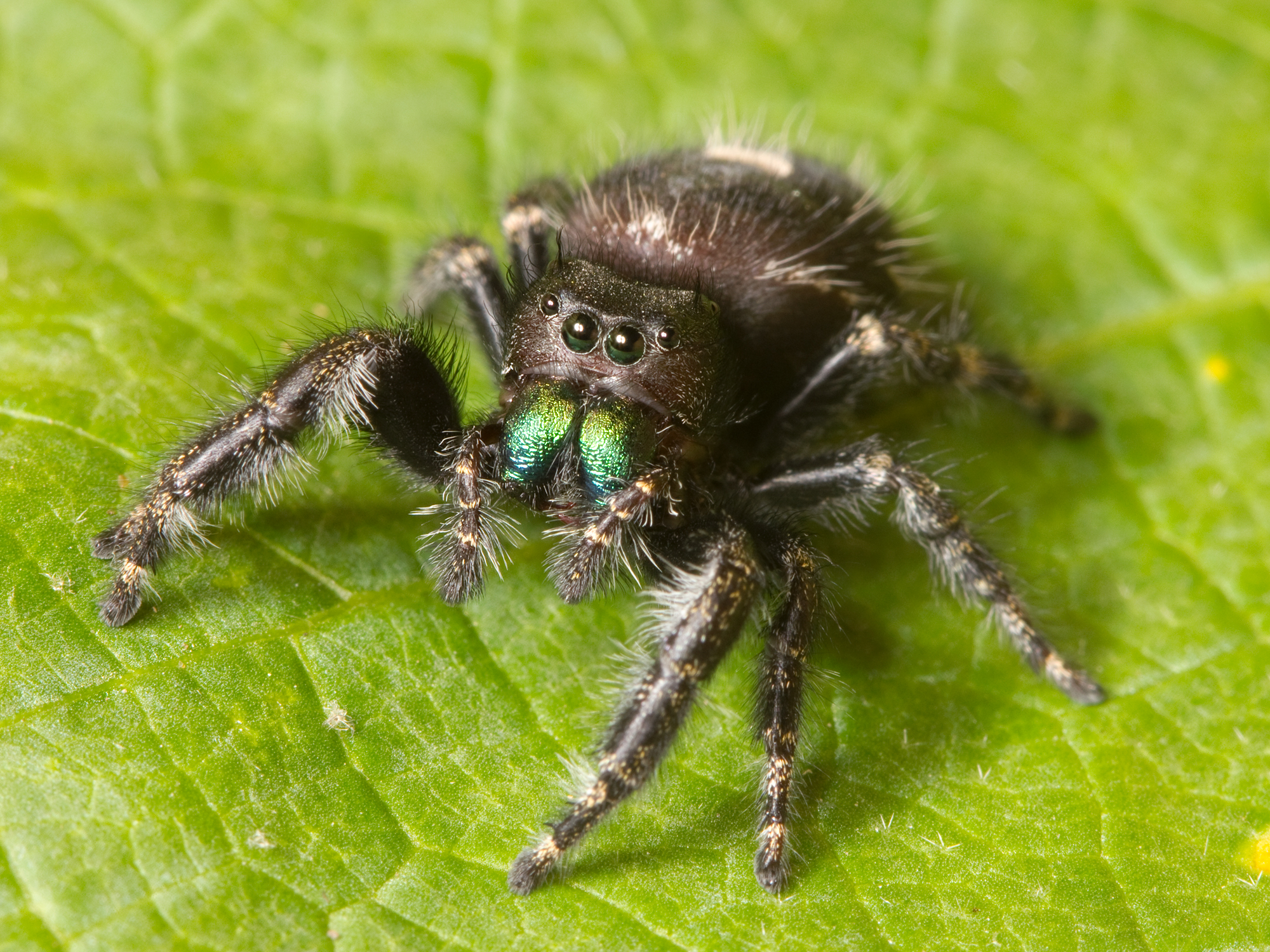|
Aculepeira Ceropegia
''Aculepeira ceropegia'', the oak spider, is an orb-weaving spider species belonging to the family Araneidae. Distribution This species has a Palearctic distribution. It is present in most of Europe.Levi, 197 The orb-weaver genera Metepeira, Kaira and Aculepeira in America north of Mexico (Araneae, Araneidae)Bulletin of the Museum of Comparative Zoology at Harvard College, no 148: p. 185-238 Habitat This quite common species live in low bushes, wet meadows, near streams, roadsides and gardens, especially in sunny and windy areas. It can be found in mountain areas at altitudes of up to 3600 meters. Description ''Aculepeira ceropegia'' presents a marked sexual dimorphism. These spiders can reach a length of in males, of in females. They are easy to identify due to their unique abdominal marking in the form of an oak leaf. The head is covered by a grayish-brown hairs, chelicerae are light brown and legs are dark ringed. The abdomen is elongated and oval-shaped. Biology Adults ... [...More Info...] [...Related Items...] OR: [Wikipedia] [Google] [Baidu] |
Charles Athanase Walckenaer
Baron Charles Athanase Walckenaer (25 December 1771 – 28 April 1852) was a French civil servant and scientist. Biography Walckenaer was born in Paris and studied at the universities of Oxford and Glasgow. In 1793 he was appointed head of the military transports in the Pyrenees, after which he pursued technical studies at the École Nationale des Ponts et Chaussées and the École polytechnique. He was elected member of the Institut de France in 1813, was mayor (''maire'') in the 5th arrondissement in Paris and secretary-general of the prefect of the Seine 1816–1825. He was made a baron in 1823. In 1839 he was appointed conservator for the Department of Maps at the Royal Library in Paris and in 1840 secretary for life in the Académie des Inscriptions et Belles Lettres. He was one of the founders of the Société entomologique de France in 1832, and a "resident member" of the Société des observateurs de l'homme. Walckenaer introduced the full biography according ... [...More Info...] [...Related Items...] OR: [Wikipedia] [Google] [Baidu] |
Araneidae
Orb-weaver spiders are members of the spider family Araneidae. They are the most common group of builders of spiral wheel-shaped webs often found in gardens, fields, and forests. The English word "orb" can mean "circular", hence the English name of the group. Araneids have eight similar eyes, hairy or spiny legs, and no stridulating organs. The family has a cosmopolitan distribution, including many well-known large or brightly colored garden spiders. With 3,108 species in 186 genera worldwide, the Araneidae comprise the third-largest family of spiders (behind the Salticidae and Linyphiidae). Araneid webs are constructed in a stereotypical fashion, where a framework of nonsticky silk is built up before the spider adds a final spiral of silk covered in sticky droplets. Orb webs are also produced by members of other spider families. The long-jawed orb weavers (Tetragnathidae) were formerly included in the Araneidae; they are closely related, being part of the superfamily Aran ... [...More Info...] [...Related Items...] OR: [Wikipedia] [Google] [Baidu] |
Wet Meadow
A wet meadow is a type of wetland with soils that are saturated for part or all of the growing season. Debate exists whether a wet meadow is a type of marsh or a completely separate type of wetland. Wet prairies and wet savannas are hydrologically similar. Wet meadows may occur because of restricted drainage or the receipt of large amounts of water from rain or melted snow. They may also occur in riparian zones and around the shores of large lakes. Unlike a marsh or swamp, a wet meadow does not have standing water present except for brief to moderate periods during the growing season. Instead, the ground in a wet meadow fluctuates between brief periods of inundation and longer periods of saturation. Wet meadows often have large numbers of wetland plant species, which frequently survive as buried seeds during dry periods, and then regenerate after flooding. Wet meadows therefore do not usually support aquatic life such as fish. They typically have a high diversity of plant ... [...More Info...] [...Related Items...] OR: [Wikipedia] [Google] [Baidu] |
Sexual Dimorphism
Sexual dimorphism is the condition where the sexes of the same animal and/or plant species exhibit different morphological characteristics, particularly characteristics not directly involved in reproduction. The condition occurs in most animals and some plants. Differences may include secondary sex characteristics, size, weight, colour, markings, or behavioural or cognitive traits. These differences may be subtle or exaggerated and may be subjected to sexual selection and natural selection. The opposite of dimorphism is ''monomorphism'', which is when both biological sexes are phenotypically indistinguishable from each other. Overview Ornamentation and coloration Common and easily identified types of dimorphism consist of ornamentation and coloration, though not always apparent. A difference in coloration of sexes within a given species is called sexual dichromatism, which is commonly seen in many species of birds and reptiles. Sexual selection leads to the exaggerat ... [...More Info...] [...Related Items...] OR: [Wikipedia] [Google] [Baidu] |
Aculepeira
''Aculepeira'' is a genus of Araneidae, orb-weaver spiders first described by Ralph Vary Chamberlin, R. V. Chamberlin & Wilton Ivie in 1942. Species it contains twenty-seven species: *''Aculepeira aculifera'' (O. Pickard-Cambridge, 1889) – USA to Guatemala *''Aculepeira albovittata'' (Mello-Leitão, 1941) – Paraguay, Argentina *''Aculepeira angeloi'' Álvares, Loyola & De Maria, 2005 – Brazil *''Aculepeira apa'' Levi, 1991 – Paraguay *''Aculepeira armida'' (Audouin, 1826) – Southern Europe, Turkey, Israel, Russia (Europe to Far East), Central Asia to China **''Aculepeira armida, Aculepeira a. orientalis'' (Kulczyński, 1901) – Russia (Asia), China **''Aculepeira armida, Aculepeira a. pumila'' (Simon, 1929) – France *''Aculepeira azul'' Levi, 1991 – Panama *''Aculepeira busu'' Levi, 1991 – Hispaniola *''Aculepeira carbonaria'' (L. Koch, 1869) – Alps, southern Europe, Turkey, Russia (Europe and Central Asia), Kazakhstan, China **''Aculepeira carbonaria, Aculepe ... [...More Info...] [...Related Items...] OR: [Wikipedia] [Google] [Baidu] |
Epigynum (spider)
The epigyne or epigynum is the external genital structure of female spiders. As the epigyne varies greatly in form in different species, even in closely related ones, it often provides the most distinctive characteristic for recognizing species. It consists of a small, hardened portion of the exoskeleton located on the underside of the abdomen, in front of the epigastric furrow and between the epigastric plates. Functions The primary function of the epigyne is to receive and direct the palpal organ of the male during copulation. The various specific forms of epigynes are correlated, in each case, with corresponding specific differences in the palpus of the male. This specialization prevents individuals of different species from mating. The epigyne covers or accompanies the openings of the spermathecae, which are pouches for receiving and retaining sperm. Frequently, the openings of the spermathecae are on the outer face of the epigyne and can be easily seen. A secondary functio ... [...More Info...] [...Related Items...] OR: [Wikipedia] [Google] [Baidu] |
Chelicerae
The chelicerae () are the mouthparts of the subphylum Chelicerata, an arthropod group that includes arachnids, horseshoe crabs, and sea spiders. Commonly referred to as " jaws", chelicerae may be shaped as either articulated fangs, or similarly to pincers. Some chelicerae, such as those found on nearly all spiders, are hollow and contain (or are connected to) venom glands, and are used to inject venom into prey or a perceived threat. In '' Pisaurina mira'', also known as the nursery web spider, the chelicerae are utilized to snatch the prey once it becomes within reach, facilitating the "sit-and-wait ambush predator" behavior. Both pseudoscorpions and harvestmen have structures on their chelicerae that are used for grooming (papillae in pseudoscorpions, cheliceral teeth in Opiliones). Types Chelicerae can be divided into three kinds: jackknife chelicerae, scissor chelicerae, and 3-segmented chelate chelicerae. Jackknife chelicerae The jackknife chelicera is subchelate ... [...More Info...] [...Related Items...] OR: [Wikipedia] [Google] [Baidu] |
Ceropegia
''Ceropegia'' is a genus of plants within the family Apocynaceae, native to Africa, southern Asia, and Australia. It was named by Carl Linnaeus, who first described this genus in his ''Genera plantarum'', which appeared in 1737. Linnaeus referred to the description and picture of a plant in the ''Horti Malabarici'' as the plant for which the genus was created. In 1753 he named this species as '' Ceropegia candelabrum''. Linnaeus did not explain the etymology but later explanations stated that the name ''Ceropegia'' was from the Greek word ''keropegion'' κηροπηγɩον. This means ''candelabrum'' in Latin, which has a broader range than the modern word - "a candlestick, a branched candlestick, a chandelier, candelabrum, or also lamp-stand, light-stand, sometimes of exquisite workmanship". An alternative explanation for the name was given later by William Jackson Hooker in 1830 in ''Curtis's Botanical Magazine'' in the description of '' Ceropegia elegans'': "From '' κηρό ... [...More Info...] [...Related Items...] OR: [Wikipedia] [Google] [Baidu] |
Spiders Of Europe
Spiders (order Araneae) are air-breathing arthropods that have eight legs, chelicerae with fangs generally able to inject venom, and spinnerets that extrude silk. They are the largest order of arachnids and rank seventh in total species diversity among all orders of organisms. Spiders are found worldwide on every continent except for Antarctica, and have become established in nearly every land habitat. , 50,356 spider species in 132 families have been recorded by taxonomists. However, there has been debate among scientists about how families should be classified, with over 20 different classifications proposed since 1900. Anatomically, spiders (as with all arachnids) differ from other arthropods in that the usual body segments are fused into two tagmata, the cephalothorax or prosoma, and the opisthosoma, or abdomen, and joined by a small, cylindrical pedicel, however, as there is currently neither paleontological nor embryological evidence that spiders ever had a separat ... [...More Info...] [...Related Items...] OR: [Wikipedia] [Google] [Baidu] |
Spiders Described In 1802
Spiders (order Araneae) are air-breathing arthropods that have eight legs, chelicerae with fangs generally able to inject venom, and spinnerets that extrude silk. They are the largest order of arachnids and rank seventh in total species diversity among all orders of organisms. Spiders are found worldwide on every continent except for Antarctica, and have become established in nearly every land habitat. , 50,356 spider species in 132 families have been recorded by taxonomists. However, there has been debate among scientists about how families should be classified, with over 20 different classifications proposed since 1900. Anatomically, spiders (as with all arachnids) differ from other arthropods in that the usual body segments are fused into two tagmata, the cephalothorax or prosoma, and the opisthosoma, or abdomen, and joined by a small, cylindrical pedicel, however, as there is currently neither paleontological nor embryological evidence that spiders ever had a separate th ... [...More Info...] [...Related Items...] OR: [Wikipedia] [Google] [Baidu] |






